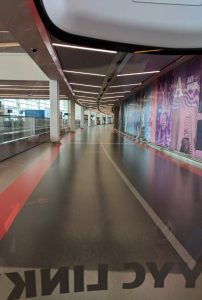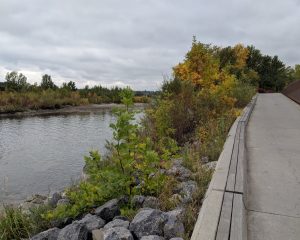Last week I had an unexpected 12 hours to spend at the Calgary International Airport, providing me plenty of time to consider all that I learned at the Designing Libraries conference. While the airport provided fun rides between terminals and the wi-fi was robust, the distractions (like food, bookstores, cozy chairs), unfortunately, were minimal.
Designing Libraries brings librarians, researchers, designers, planners and architects together to discuss the future of libraries, particularly how new technologies support new ways of doing research and supporting students in their learning. The conference is currently sponsored by the Coalition for Networked Information (CNI), North Carolina State University Libraries, and the University of Calgary Libraries.
Joan Lippincott (CNI) summed up the key discussion threads in this way:
We are:
- Integrating our thinking about what we want users to be able to do in relation to space
- Articulating more clearly the relationship of programs to institutional priorities
- And we have a growing “appetite” for digging deeper into post-occupancy assessment.
Joan was persistent in asking those hard questions of assessment:
- How do you demonstrate how the new space relates to the creation on new knowledge?”
- How are spaces contributing to learning?
- How do you determine impact, either quantitatively or qualitatively?
Assessment is a topic I’d like to see addressed again at future conferences, and something we need to plan for at Temple as we near the opening of the Charles Library. Assessment is important because it requires us to consider, before any project is initiated, what it is we want to accomplish with the new space, the new service, the new resources?
As we plan for the opening of the Charles Library, let’s ask:
- What are our new expectations for the building, and the kind of research, learning, and partnerships it will support?
- What does that kind of engagement on the part of faculty, students and staff look like?
- While we’re focusing on the digital scholarship and instruction aspects of the space, what are the other opportunities for assessment? What are the different ways the collection is being used? More use of electronic? Less use of the physical collection, or different parts of the physical collection? Is this due to the different access, or is it due to different discovery opportunities?
- Certainly, we anticipate opportunities for collaboration and communication within the space. How else might the building facilitate a different kind of organizational culture?
Greg Raschke said of the Hunt Library at NCSU (a Snohetta project, like the Charles Library) “Hunt was a meteorite opportunity. If you miss it, it will set you back. If you overdo it, you can always scale back, but if you miss that opportunity for change, you’ll never get there. Use failures and successes as a way of evolving your organization.”
Architect Craig Dykers, of Snohetta, also spoke of the transformative value of the library – it can be a place for both safe dialog AND disagreement; both a welcoming space AND a challenging one. The library is something always transforming, but should serve as a transformational space as well. Sort of like the path along Calgary’s Bow River.


